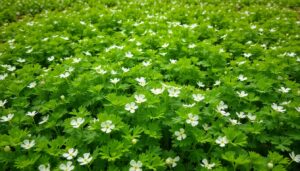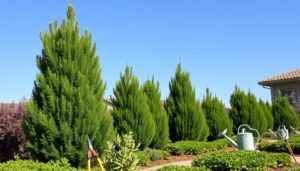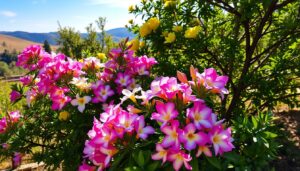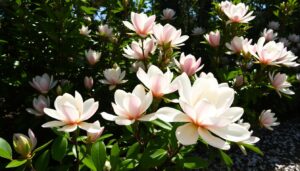Juniper Maintenance Needs in Landscape : Struggling to keep your junipers looking vibrant and healthy? Mastering juniper maintenance can transform your outdoor space. It can go from ordinary to extraordinary.
Junipers are resilient evergreen shrubs. They add stunning texture and year-round color to your landscape. With the right care, you can create a thriving green environment that requires minimal effort.
Landscape designers love these plants for their adaptability and low-maintenance nature. Professional gardening resources suggest understanding each juniper’s unique characteristics. This ensures optimal growth.
This guide will show you how to nurture junipers. You’ll learn from selecting the perfect variety to implementing strategic maintenance practices. Whether you’re a seasoned gardener or a landscaping novice, you’ll find practical insights to help your junipers flourish.
By following our expert juniper maintenance needs landscape recommendations, you’ll create a stunning outdoor space. It will remain lush and beautiful throughout the seasons.
Table of Contents
Understanding Juniper Varieties
Choosing the right juniper for your landscape is key for good care. Junipers come in many types, each with its own look and how well it adapts.
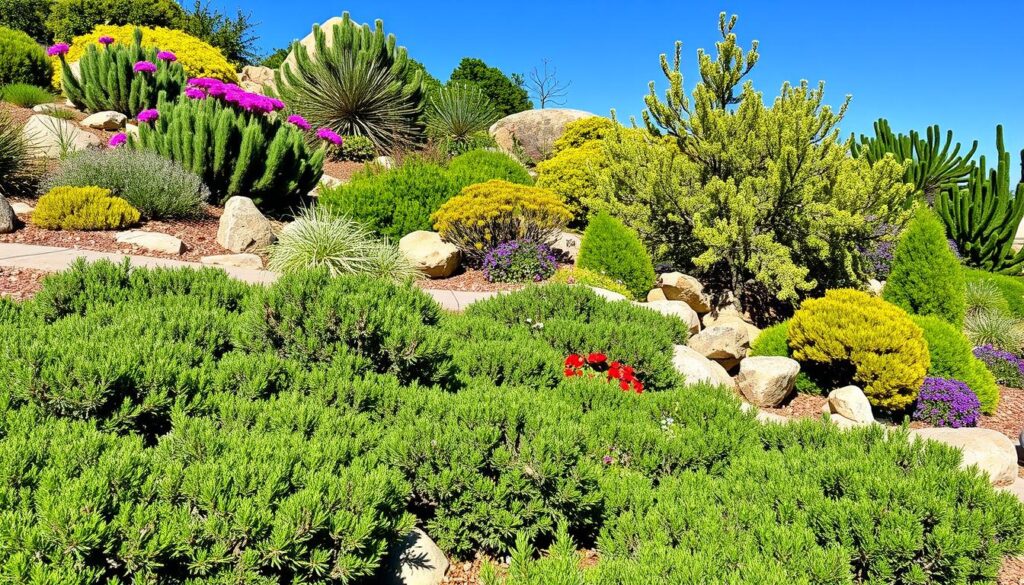
Native junipers are great for your garden. Juniperus horizontalis, or Creeping Juniper, is a top pick. It’s tough and looks great in your yard.
Common Types of Juniper in Landscapes
Experts know many juniper types:
- Creeping Juniper (Juniperus horizontalis)
- Hollywood Juniper (Juniperus chinensis ‘Torulosa’)
- Blue Point Juniper
- Sea Green Juniper
Choosing the Right Juniper for Your Space
Think about these things when picking junipers:
| Variety | Height | Spread | Drought Tolerance |
|---|---|---|---|
| Creeping Juniper | 18 inches | 5-8 feet | High |
| Hollywood Juniper | 15-20 feet | 10-15 feet | Moderate |
| Blue Point Juniper | 12-15 feet | 6-8 feet | High |
“Native junipers are not just plants; they’re living landscapes that adapt and thrive in challenging conditions.”
Knowing these details helps you pick the best juniper for your yard. Each type adds something special to your outdoor space.
Optimal Planting Conditions for Junipers
Creating the perfect environment for junipers is key for their health and growth. A good landscaping company knows that the right planting conditions are crucial. They help junipers grow well and live long.
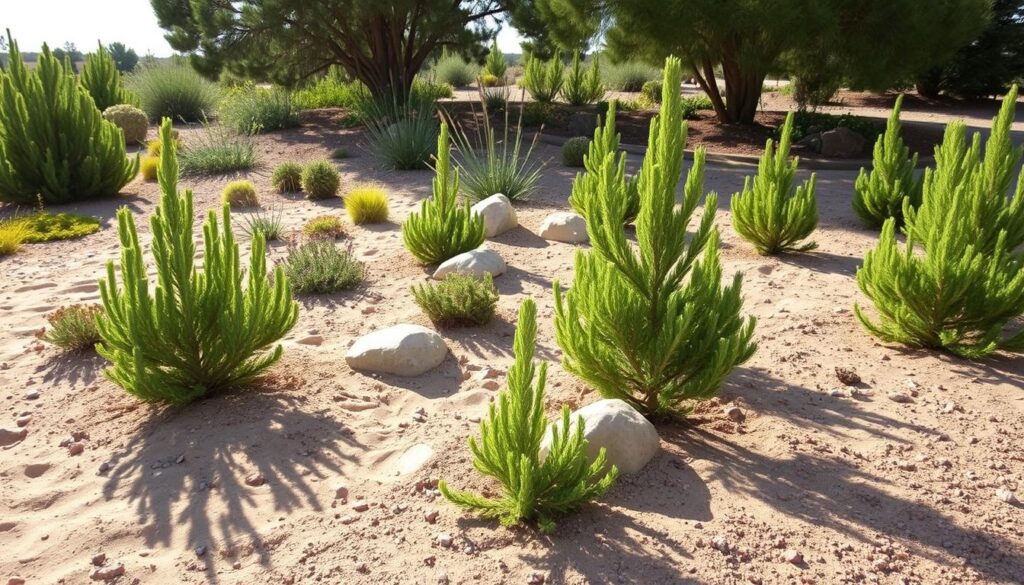
Your juniper care checklist should begin with knowing what these plants need. Understanding their basic needs is the first step.
Soil Requirements for Healthy Growth
Junipers need specific soil to thrive. Here are the main soil points:
- Well-drained soil is critical for juniper survival
- Prefer slightly acidic to neutral pH levels (6.0-7.0)
- Avoid heavy clay or consistently waterlogged areas
Sunlight Preferences and Placement Tips
Choosing the right spot is vital for juniper success. Most types need full sun to grow well.
“The right placement can transform a struggling juniper into a landscape showpiece.” – Landscape Design Expert
| Juniper Type | Sun Requirement | Ideal Placement |
|---|---|---|
| Creeping Juniper | Full Sun | Open areas with direct sunlight |
| Upright Juniper | 6-8 hours direct sun | South or west-facing locations |
| Ground Cover Juniper | Partial to Full Sun | Slopes, rock gardens |
A pro landscaping company suggests thinking about your yard’s microclimates. This helps place junipers for the best growth.
Watering Guidelines for Juniper Maintenance
Proper watering is key for juniper tree care. Knowing the right moisture balance keeps your outdoor spaces healthy. It also helps your junipers grow well in different environments.
For juniper care, managing water is very important. These plants need water in a way that’s different from most other plants.
How Often to Water Your Juniper
Junipers are very good at handling drought. They don’t need to be watered often. Here are some tips for watering them right:
- Check soil moisture before watering – the top inch should feel dry
- Water early in the day to maximize absorption
- Reduce watering frequency during winter months
- Adjust watering based on climate and specific juniper variety
“Junipers prefer deep, infrequent watering over constant moisture,” says landscape expert Sarah Thompson.
Signs of Underwatering vs. Overwatering
It’s important to know when your juniper needs more or less water. Different signs show if your plant is stressed from too little or too much water.
| Underwatering Signs | Overwatering Signs |
|---|---|
| Brittle, dry branches | Yellowing needles |
| Browning foliage | Soft, mushy root system |
| Slow growth | Fungal growth near base |
Mature junipers usually only need water during really dry times. A good landscape care plan includes checking soil and plant health often.
By following these watering tips, you can keep your junipers healthy and beautiful. They will be a great addition to your landscape design.
Pruning Techniques for Junipers
Proper pruning is key for junipers in commercial landscaping. Knowing the right techniques helps manage your juniper landscape. This ensures your plants stay vibrant and well-shaped.
When to Prune Junipers
Timing is crucial for pruning junipers. The best times are:
- Late winter or early spring before new growth
- Early summer after the first new growth
- Avoid late summer or fall to prevent damage
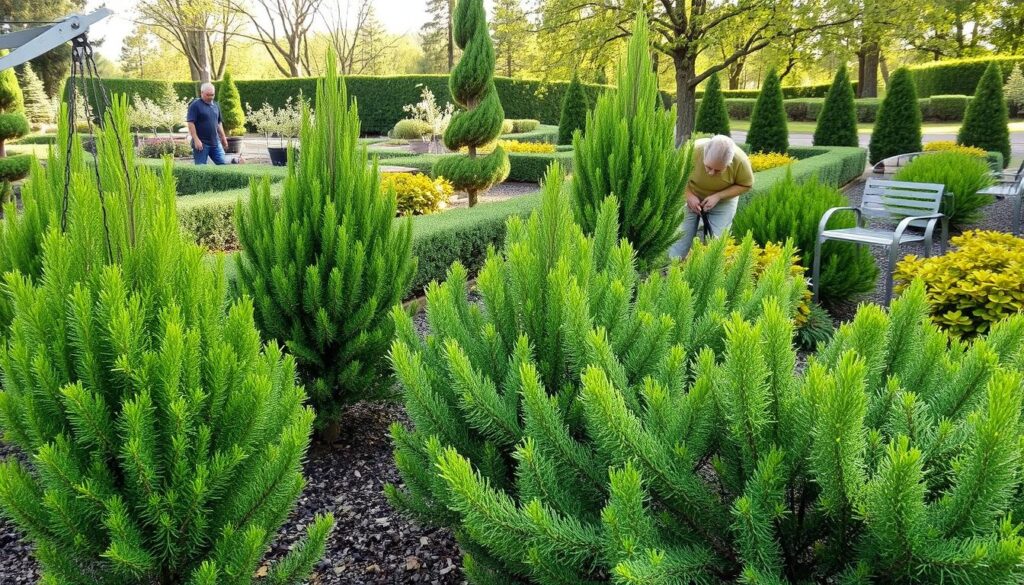
Essential Pruning Tools
To manage your juniper landscape, you need the right tools:
| Tool | Purpose | Recommended Type |
|---|---|---|
| Hand Pruners | Trimming small branches | Bypass pruners |
| Loppers | Cutting thicker branches | Long-handled loppers |
| Sanitizing Solution | Prevent disease spread | Rubbing alcohol |
“Sharp, clean tools are the key to healthy pruning and plant maintenance.”
Always sanitize your tools between plants to stop disease. When pruning, cut at a 45-degree angle just above a growth node. Don’t cut into woody areas without green growth, as they won’t heal.
Regular pruning is vital for commercial landscaping. It controls size, removes dead branches, and keeps shapes. With careful pruning, your junipers will look great all year.
Fertilizing Junipers for Best Results
Proper fertilization is key to keeping junipers healthy and vibrant. Knowing the right way to care for them can make your landscape look great and keep your plants healthy.
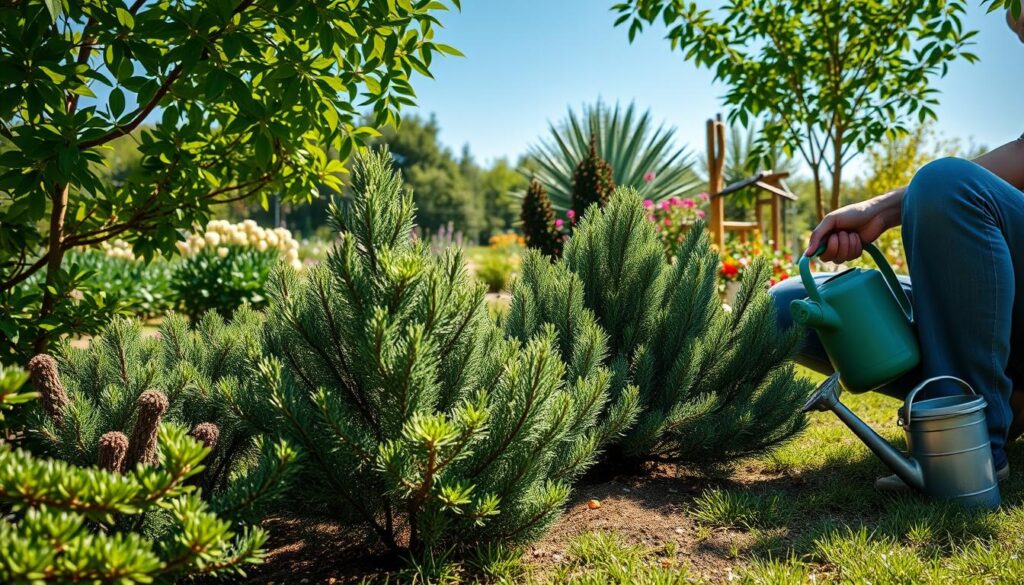
Choosing the right fertilizer for your junipers is important. Different types need different nutrients to grow well and stay strong.
Recommended Fertilizer Types
- Slow-release nitrogen-based fertilizers
- Balanced NPK formulations (10-10-10 or 14-14-14)
- Smart-release plant food designed for evergreen shrubs
Fertilization Scheduling
When to fertilize junipers is just as important as what to use. They usually do best in early spring, before they start growing again.
| Season | Fertilization Recommendation |
|---|---|
| Early Spring | Primary fertilization period |
| Late Spring | Light supplemental feeding |
| Summer | Minimal to no fertilization |
| Fall | Avoid fertilizing to prevent new growth |
“Proper fertilization is the foundation of healthy juniper growth and landscape beauty.”
Always test your soil to find out what nutrients your junipers need. Too much fertilizer can harm these tough plants. So, it’s important to use just the right amount in your landscaping.
Pest and Disease Management for Junipers
Keeping your junipers safe from pests and diseases is key. Healthy junipers need regular checks and quick action to stop problems. This keeps them strong and thriving.
Make sure to check your junipers often. This way, you can spot issues early. Common pests and diseases can harm these plants if not treated.
Common Pests Targeting Junipers
- Spider Mites: Tiny arachnids that create webs and drain plant nutrients
- Bagworms that create distinctive protective casings
- Aphids that cluster and feed on plant sap
- Scale insects that attach to branches and stems
Identifying Plant Diseases
Look out for these signs during your maintenance:
- Discoloration of needles
- Unusual growth patterns
- Presence of fungal growths
- Sudden branch dieback
“Prevention is always better than cure in plant health management.”
Use a mix of methods to treat pests and diseases. Natural options like neem oil work well. They help control pests without harming the environment.
Having a detailed maintenance plan keeps your junipers healthy. This way, they stay strong against threats all season long.
Mulching and Ground Cover Considerations
Mulching is key for juniper plant care. It can change how you maintain your outdoor space. Knowing the best mulching methods helps your juniper plants thrive.
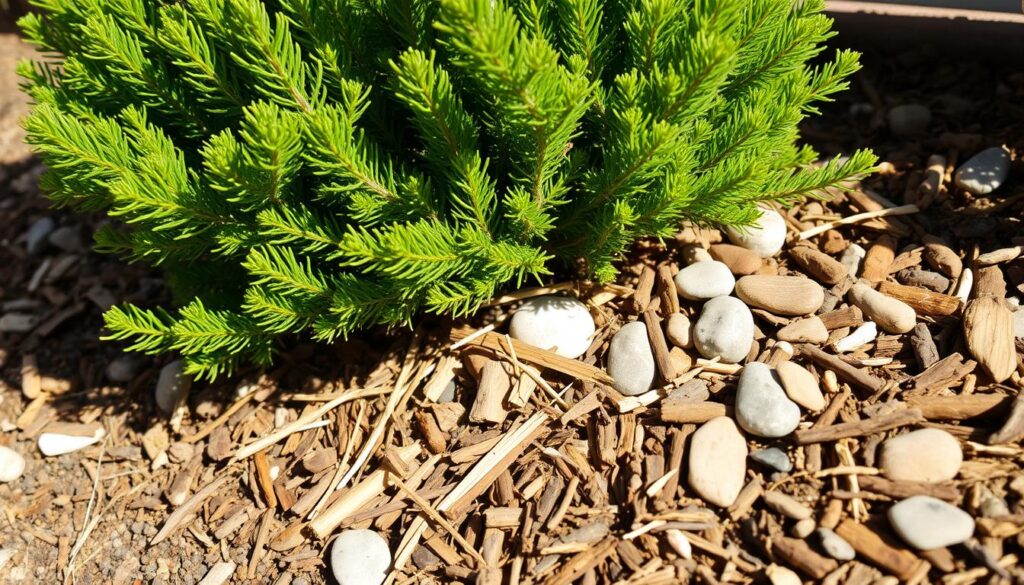
Good mulching does many things for your junipers. It keeps the soil moist, stops weeds, controls soil temperature, and protects roots.
Best Mulch Options for Junipers
Choosing the right mulch is important for juniper care. Each mulch type has its own benefits for your garden.
| Mulch Type | Benefits | Best For |
|---|---|---|
| Organic Bark Chips | Slow decomposition, natural appearance | Moisture retention |
| Pine Needles | Acidic soil improvement | Creeping Juniper varieties |
| Gravel | Excellent drainage | Drought-tolerant Juniper species |
| Cocoa Hulls | Attractive color, nutrient-rich | Decorative landscape areas |
Apply mulch 2-3 inches thick around your junipers. Keep it away from the base to avoid rot.
“The right mulch can be the difference between a struggling and a thriving juniper landscape.” – Landscape Design Expert
Ground Cover Strategies
Think about plants that go well with your junipers. Native ground covers like Creeping Juniper spread wide but stay low. They make for a stunning, easy-to-care-for garden.
Seasonal Care for Junipers
Keeping junipers healthy all year needs a good plan. Experts in commercial landscaping know junipers need special care in different weather. Your care plan should change with the seasons.
Extreme weather can harm your junipers. But, with the right care, they can stay healthy and look great. Even native junipers need special attention.
Preparing Junipers for Winter
Winter is a big challenge for junipers. Here’s how to prepare:
- Water them less as it gets colder
- Put mulch around the base to protect
- Keep young or weak junipers safe from strong winds
- Stay away from salt-based ice melt near their roots
Spring Care Tips for Vibrant Growth
Spring is a time to make your junipers thrive. Good spring care can really help their health and look.
- Look for damage from winter
- Trim off dead or broken branches
- Feed them with balanced, slow-release fertilizer
- Check if the soil drains well and is moist
“Consistent care is the secret to thriving junipers across all seasons.”
With these seasonal tips, your junipers will grow strong and look beautiful. This is true for both homes and commercial areas.
Ensuring Juniper Longevity
Keeping junipers healthy needs careful care and watching for signs of stress. Knowing how to spot these signs and act early is key. This helps your landscape stay beautiful for a long time.
There are important steps to protect your junipers. These steps help them grow strong and stay healthy for years.
Techniques for Extending Juniper Life
- Maintain consistent watering schedules
- Monitor soil drainage carefully
- Protect roots from extreme temperature fluctuations
- Prune strategically to promote air circulation
A landscaping maintenance company can help you use these techniques. They know how to make sure your junipers thrive.
Recognizing Signs of Stress in Plant Life
Spotting stress in junipers early is vital. Look out for these signs:
- Discoloration of needles – yellowing or browning
- Unusual branch dieback
- Reduced new growth
- Visible pest infestations
“Prevention is always more effective than cure in plant care.”
Regular checks can catch problems before they get worse. Think about getting help from a professional landscaping maintenance service for a detailed check-up.
Enhancing Your Landscape with Junipers
Junipers can turn your outdoor space into something amazing. These evergreens bring beauty and interest all year round. They’re great for ground cover or as garden highlights.
Choosing the right spot for junipers is crucial. Creeping Juniper spreads wide but stays short, perfect for rock gardens. Get tips from experts on juniper care to match your landscape and climate.
Design Ideas for Using Junipers
Use different juniper types for depth and texture. ‘Blue Rug’ Juniper is great for hanging over walls. Larger ones can be architectural wonders. Mix heights and spreads for interest.
Pairing Junipers with Other Plants
Pair junipers with plants that contrast in texture and color. Drought-tolerant plants and grasses complement junipers well. Native junipers also attract wildlife, enhancing your garden’s ecosystem.
FAQ
What are the most common juniper varieties for landscaping?
Popular juniper types include Creeping Juniper (Juniperus horizontalis) and Hollywood Juniper (Juniperus chinensis ‘Torulosa’). They have different looks and growth patterns. This makes them great for many landscape designs.
How often should I water my juniper plants?
How often you water depends on the climate, soil, and the plant’s age. Young junipers need more water, while older ones can handle less. Water deeply but not too often. In hot weather, you might need to water more.
When is the best time to prune junipers?
Prune junipers in late winter or early spring. This is before new growth starts. Prune in late summer or fall and you might get new growth that won’t survive winter. Always use sharp tools and remove dead or damaged branches.
What type of fertilizer is best for junipers?
Use a balanced fertilizer like 10-10-10 or one made for evergreen shrubs. Apply it in early spring. Don’t over-fertilize, as junipers are easy to care for.
How do I protect my junipers from pests and diseases?
Keep your junipers healthy by watering, pruning, and spacing them right. Watch out for pests and diseases like spider mites and fungal infections. Good air flow and regular checks are key. Treat problems with insecticidal soaps or fungicides and remove sick plants.
Can junipers grow in full shade?
Junipers like full sun to partial shade. They can handle some shade but grow best in direct sunlight. Less sun can make them look sparse and weak.
How do I mulch around my juniper plants?
Put a 2-3 inch layer of organic mulch around the plant, but not touching the trunk. Use pine bark, wood chips, or small stones. Mulching keeps the soil moist, stops weeds, and keeps the temperature right.
What are signs that my juniper is stressed?
Look for yellow leaves, dead branches, slow growth, or too many needles falling off. These signs mean the plant might be stressed. It could be due to watering, soil, pests, or weather.


